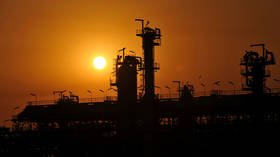Iran plans petrochemical BOOM despite US sanctions

Iran’s petchems sector now accounts for over 30 percent of all its non-oil exports and Tehran is planning to boost this further through the build-out of a number of dedicated hubs.
Given the extreme unlikelihood of the US returning to the currently structured Joint Comprehensive Plan of Action (JCPOA), and Iran’s unwillingness to renegotiate the deal any time soon, the Islamic Republic remains focused on three key areas where it can make money despite ongoing sanctions form Washington. Alongside the continued development of its huge West Karoun oil fields, the completion of the supergiant South Pars non-associated gas offshore sector (including the implementation of Phase 11 operations), and the finalisation of the crude oil transfer pipeline from Guriyeh to Jask, Iran’s core focus in the current sanctions environment is to optimise the output and revenues from its already world-scale petrochemicals sector. This has always played a key role in Iran’s ‘resistance economy’ model, the concept of generating value-added returns by leveraging intellectual capital into business development wherever possible. Iran’s petchems sector now accounts for over 30 percent of all its non-oil exports and Tehran is planning to boost this further through the build-out of a number of dedicated petchems hubs.
Also on rt.com US sells over a million barrels of seized Iranian fuel headed for VenezuelaA key advantage for Iran in pushing the petchems sector – aside from the ongoing financial, technology, and personnel support of China and Russia – is that from a legal perspective it has always occupied a grey area as far as sanctions have been concerned. When the previous set of major sanctions were at their height in 2011/12, Iran’s petrochemical industry was the subject of US and EU sanctions, and the only way for Iran to sell such products ‘legally’ was to customers outside the US and EU. At that time, secondary sanctions were in place in the US on any person worldwide that purchased, acquired, sold, transported, or marketed Iranian-origin petrochemical products, or provided goods or services valued at $250,000 or more (or $1 million over a 12-month period) for use in Iran’s production of petrochemical products. In the EU there was a ban on the import, purchase, or transportation of Iran-origin petrochemical products, and on the export to Iran of certain equipment for use in the petrochemical industry. In stark contrast to the previous sanctions era, there are currently no EU sanctions specifically on Iran’s petchems sector and nor are there plans to impose them. Crucially as well, the US cannot currently exert jurisdiction for ‘primary’ sanctions unless US persons are involved – notably US banks and US employees.
READ MORE: Iran sends BIGGEST EVER fleet of oil tankers to Venezuela, defying US sanctions – report
In basic terms, a total of $11.5 billion-worth of petchems projects will have been launched in Iran in the year ending 20 March 2021, according to Iran’s deputy minister of petroleum for petrochemical affairs, Behzad Mohammadi. These will add at least 25 million tons to the country’s annual production capacity, bringing it up to at least 90 million tons per year (mtpy), and within a hair’s breadth of the 100 mtpy production target that is due to be achieved by the end of 2025. Iran’s Petroleum Minister, Bijan Zanganeh, further specified that this next major phase of the country’s petchems sector development will consist of 17 new projects in the next 12 months, which will enable a more than doubling of the value of it to Iran from $12 billion in 2013 (when the first major phase was pushed) to $25 billion by the end of next calendar year, and to at least $37 billion by March 2026. At the same time, the ability to produce petchems will be boosted by dramatic increases in feedstock, according to a comment last week from the chief executive officer of Iran’s National Petrochemical Company (NPC), Behzad Mohammadi, last week. This will reach at least 2.2 million barrels per day (bpd) by early 2026, and will be complemented by gas production gains already in progress in South Pars and other major gas fields. Already though, said Zanganeh last week, gas production in Iran has hit a record of over its key target point of 1 billion cubic metres per day (BcM/d) – at 1.04 Bcm/d – with nearly 70 percent of this coming from the supergiant South Pars gas field. With these feedstock increases in place, Zanganeh stated last week that Iran’s petrochemical production capacity would reach 100 million tons per year by 2022.
Also on rt.com Iran’s mega South Pars gas field nears completionIt is to assist in and expedite this process further that Iran is building out a number of petchems hubs, to add to the current major centres in Bushehr and Khuzestan. According to Zanganeh last week, Iran has worked out plans to convert the western province of Kermanshah into the third petrochemical hub of the country to exploit the readily accessible gas supplies in the area, with at least $500 million of investment accompanying this build-out in the upstream and downstream parts of it. The Kermanshah Petrochemicals Hub is to focus on the production of propylene (also called propylene or methyl ethylene), he added, as it is one of the most valuable industrial substances and Kermanshah already produces around 300,000 tons of polyethylene. Additionally, the landmark West Ethylene Pipeline passes through the province, which will run 1,660 kilometres from Assaluyeh in southern Iran to Tabriz in the northwest of the country, making it the longest ethylene line in the world. “From March 2020 to March 2021…about two million tons of ethylene will be transferred through the West Ethylene pipeline… [and] Iran’s ethylene output will reach seven million tons per year by March 2021,” according to Zanganeh.
In the same vein, the NPC’s Mohammadi said last week that Qeshm Island – located to the south of the key petchems facility in Bandar Abbas, and at the farthest point east of the Strait of Hormuz where it turns south into the Gulf of Oman (with unbroken access then to the Far East and East Africa) – is ideally placed to also become a major hub of construction, development, production, and export of a variety of petrochemical products. He added that so far permits have been issued for the development of petrochemical industries in Qeshm Island, Special Parsian Economic Zone, Bandar-e-Jask, and Iran’s Mokran Coastal Region. This latter area is located in Baluchestan province in south-eastern Iran and south-western Pakistan, and also has a 1,000 kilometre coastal stretch along the Gulf of Oman from al-Kuh, Iran (west of Jask), to the Lasbela District of Pakistan (near Karachi). According to Iranian sources who work closely with the current government in Iran spoken to exclusively by OilPrice.com last week, these coastal routes east are a short-term measure to facilitate the full export capability of oil and gas via the originally intended Iran-Pakistan Pipeline (IPP). The original agreement for the IPP, signed between Iran and Pakistan in 1995, was predicated on the pipeline running from South Pars into Karachi but the most recent iteration of the route involves the gas running from Iran’s Asalouyeh and into Pakistan’s Gwadar and then on to Nawabshah. The latest projection of the cost of the pipeline is around $3.5 billion, although $2.5 billion of this has already been invested in the 900 kilometre stretch on Iran’s side that has already been completed. Pakistan’s 780 kilometre stretch has yet to make significant progress.
Given the geopolitical importance of both Iran and Pakistan to Russia and China, though, finding the money for the remainder of the project is unlikely to be a problem. For China, there is a threefold motivation. First, it plans to integrate the IPP into the $50 billion-plus China Pakistan Economic Corridor (CPEC) project, with Gwadar earmarked to be a key logistical node in China’s ‘One Belt, One Road’ project. Second, it wants to keep Iran (and neo-client state Iraq) as key suppliers of oil and gas in the future. And third, it regards supporting those who the US opposes (Iran and to a lesser degree Pakistan) as being a central plank of its foreign policy, over and above the short-term tactic of wrong-footing the US in the paused but still ongoing trade war. The US clearly sees it the same way, as it has from the start tried to stymie progress on the IPP. In January 2010, despite Iran being close to completing its side of the IPP pipeline, the US formally requested that Pakistan abandon the project in return for which it would receive assistance from Washington for the construction of a liquefied natural gas (LNG) terminal and for the importing of electricity from Tajikistan through Afghanistan’s Wakhan Corridor. Although the IPP agreement came back into effect briefly, July 2011 saw the US interfere again in the corporate proxy shape of energy giant ConocoPhillips, which began mediating the notion of an LNG supply deal between Pakistan and then US ally Qatar. Ultimately, this formed the basis of the 15-year agreement for Qatar to export LNG to Pakistan, signed in February 2016 that continues to this day.
By Simon Watkins for Oilprice.com














